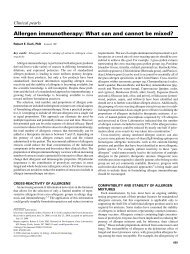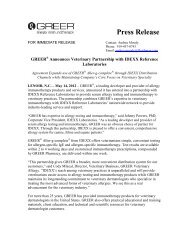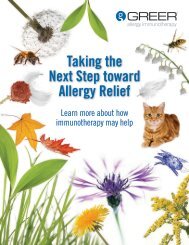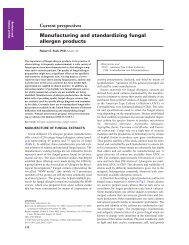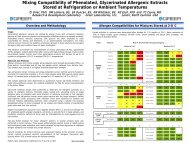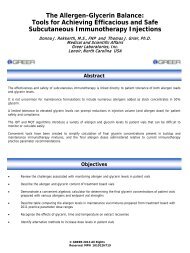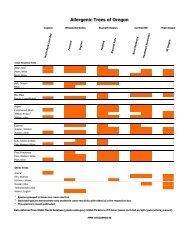Human Allergy Catalog - Greer
Human Allergy Catalog - Greer
Human Allergy Catalog - Greer
You also want an ePaper? Increase the reach of your titles
YUMPU automatically turns print PDFs into web optimized ePapers that Google loves.
HIGHLIGHTS OF PRESCRIBING INFORMATIONThese highlights do not include all the information needed to use<strong>Greer</strong> Standardized Mite Extracts safely and effectively. See fullprescribing information for <strong>Greer</strong> Standardized Mite Extracts.Standardized Mite Extract (Dermatophagoides farinae)Standardized Mite Extract (Dermatophagoides pteronyssinus)Standardized Mite Extract Mixture (Dermatophagoides farinae andDermatophagoides pteronyssinus)Solution for percutaneous, intradermal, or subcutaneousadministration.Initial U.S. Approval: 1987WARNING: ANAPHYLAXISSee full prescribing information for complete boxedwarningDo not inject intravenously (2.2)Allergenic extracts may cause severe lifethreateningsystemic reactions, including the rareoccurrence of anaphylaxis or death (5.1)Intended for use only by experts experienced inadministering allergic extracts and trained toprovide emergency treatment (5.1)Initial dose must be based on skin test (2.1)Observe patients in the office for at least 30 minutesfollowing treatment. Emergency measures andpersonnel trained in their use must be availableimmediately in the event of life threatening reaction(5.1)Immunotherapy may not be suitable for patientswith medical conditions that reduce their ability tosurvive a systemic reaction (5)-------------------------INDICATIONS AND USAGE-------------------------<strong>Greer</strong> Standardized Mite Extracts are allergenic extracts indicated forDiagnosis of skin test reactivity to dust mite allergen (1)Treatment of mite-induced allergic asthma, rhinitis and conjunctivitisin patients that show hypersensitivity to dust mites based on clinicalhistory, allergen exposure history, and skin test reactivity (1)------------------------DOSAGE AND ADMINISTRATION-----------------------The extracts are diluted with sterile diluents for allergenic extracts whenused for intradermal testing or subcutaneous immunotherapy. Dosagesvary by mode of administration, and by individual response and tolerance.Administered percutaneously for diagnostic testing (2.1); stockconcentrate 10,000 <strong>Allergy</strong> Units/mL (2.1)Administered intradermally for diagnostic testing (2.1); stockconcentrate 5,000, 10,000, or 30,000 <strong>Allergy</strong> Units/mL (2.3)Administered subcutaneously for immunotherapy (2.2); stockconcentrate of 5,000, 10,000, or 30,000 <strong>Allergy</strong> Units/ mL (2.3)--------------------DOSAGE FORMS AND STRENGTHS--------------------For percutaneous testing, <strong>Greer</strong> Standardized Mite Extract stockconcentrates containing 10,000 <strong>Allergy</strong> Units/mL ofDermatophagoides farinae (D. farinae), Dermatophagoidespteronyssinus (D. pteronyssinus), or both D. farinae and D.pteronyssinus are supplied in 5 mL dropper vials (3)For intradermal testing or immunotherapy, <strong>Greer</strong> Standardized MiteExtracts stock concentrates containing a total of 5,000, 10,000, orHIGHLIGHTS OF PRESCRIBING INFORMATION (CONTINUED)30,000 <strong>Allergy</strong> Units/mL of D. farinae, D. pteronyssinus, or a mixtureof D. farinae and D. pteronyssinus are supplied in 10, 30, and50 mL multiple-dose vials (3)--------------------------CONTRAINDICATIONS----------------------------None--------------------WARNINGS AND PRECAUTIONS--------------------All concentrates of <strong>Greer</strong> Standardized Mite Extracts can cause serioussystemic reactions of varying degrees of severity, including anaphylacticshock and death, particularly in patients:With labile or steroid-dependent asthma (5.1)With extreme sensitivity to allergen(s) (5.1)Who are currently using beta blockers (5.2)Who are on an accelerated immunotherapy build-up schedule (5.1)Who are being changed from one allergenic extract to another (5.1)Who are receiving high doses of allergen extracts (5.1)-------------------------ADVERSE REACTIONS-------------------------Systemic reactions may be fatal or near fatal (6)Systemic reactions (e.g., generalized skin erythema, urticaria,pruritus, angioedema, rhinitis, wheezing, laryngeal edema, andhypotension) occur in 4-7% of patientsThe most common reactions are local reactions at the injection site(e.g., erythema, itching, swelling, tenderness, pain), occurring in 26%to 82% of patients (6)To report SUSPECTED ADVERSE REACTIONS, contact <strong>Greer</strong>Laboratories, Inc., at 1-800-438-0088 or the FDA at 1-800-fda-1088 orwww.fda.gov/medwatch------------------------DRUG INTERACTIONS------------------------Patients who are receiving beta agonists may be unresponsive to theusual doses of epinephrine used to treat serious systemic reactions,including anaphylaxis (7.1)Patients should discontinue medications known to suppress thehistamine response prior to skin testing including: antihistamine (7.2),tricyclics (7.4), and topical corticosteroids and topical anesthetics(7.3)-------------------------USE IN SPECIFIC POPULATIONS-------------------------Pregnancy: No human or animal data. Use only if clearly needed (8.1)Autoimmune Disease: immunotherapy may exacerbate theautoimmune disease. Use only if clearly needed (5.3)See 17 for PATIENT COUNSELING INFORMATIONRevised 11/2009FULL PRESCRIBING INFORMATION : CONTENTS*WARNING: ANAPHYLAXIS1 INDICATIONS AND USAGE2 DOSAGE AND ADMINISTRATION2.1 DIAGNOSTIC TESTING2.2 IMMUNOTHERAPY2.3 DILUTION PREPARATION3 DOSAGE FORMS AND STRENGTHS4 CONTRAINDICATIONS5 WARNINGS AND PRECAUTIONS5.1 SERIOUS SYSTEMIC REACTIONS5.2 PATIENTS ON BETA BLOCKERS5.3 AUTOIMMUNE DISEASE6 ADVERSE REACTIONS7 DRUG INTERACTIONS7.1 BETA ADRENERGIC DRUGS7.2 ANTIHISTAMINES7.3 TOPICAL CORTICOSTERIODS AND ANESTHETICS7.4 TRICYCLIC ANTIDEPRESSANTS7.5 OTHER DRUGS8 USE IN SPECIFIC POPULATIONS8.1 PREGNANCY8.3 NURSING MOTHERS8.4 PEDIATRIC USE8.5 GERIATRIC USE10 OVERDOSAGE11 DESCRIPTION12 CLINICAL PHARMACOLOGY12.1 MECHANISM OF ACTION13 NONCLINICAL TOXICOLOGY13.1 CARCINOGENICITY, MUTAGENESIS, OR IMPAIRMENT OFFERTILITY14 CLINICAL STUDIES15 REFERENCES16 HOW SUPPLIED/STORAGE AND HANDLING16.1 STORAGE AND HANDLING16.2 HOW SUPPLIED17 PATIENT COUNSELING INFORMATION*Sections or subsections omitted from the Full Prescribing Information arenot listed.FULL PRESCRIBING INFORMATIONWARNING: ANAPHYLAXISDo not inject intravenously. (2.2)Allergenic extracts may potentially elicit a severe lifethreateningsystemic reaction, rarely resulting in death. (5.1)This allergenic product is intended for use only by physicianswho are experienced in the administration of allergenicextracts and the emergency care of anaphylaxis, or for useunder the guidance of an allergy specialist. (5.1)The initial dose must be based on skin test. (2.1)Observe patients in the office for at least 30 minutes followingtreatment. Emergency measures and personnel trained intheir use must be available immediately in the event of lifethreatening reaction. (5.1)Immunotherapy may not be suitable for patients withmedical conditions that reduce their ability to survive asystemic reaction, including significant cardiovascularand/or pulmonary diseases. Patients who are receiving betablockers may be unresponsive to the usual doses ofepinephrine used to treat systemic reactions, includinganaphylaxis. (5.2)1 INDICATIONS AND USAGE<strong>Greer</strong> Standardized Mite (Dermatophagoides farinae and/orDermatophagoides pteronyssinus) Extracts are allergenic extractsindicated for skin test diagnosis of mite allergy treatment of patients with mite-induced allergic asthma, rhinitisand conjunctivitis.For Immunotherapy, patients must show hypersensitivity toDermatophagoides farinae (D. farinae) or Dermatophagoidespteronyssinus (D. pteronyssinus) based on their clinical history, allergenexposure history, and skin test reactivity.2 DOSAGE AND ADMINISTRATIONDo not inject intravenously.<strong>Greer</strong> Standardized Mite extracts are diluted with sterile diluent forallergenic extracts when used for intradermal testing or subcutaneousimmunotherapy. Dosages vary by mode of administration, and byindividual response and tolerance. Parenteral drug products should beinspected visually for particulate matter and discoloration prior toadministration, whenever solution and container permit. <strong>Greer</strong>Standardized Mite Extracts should be a light brown solution that is free ofparticulate matter. If particulate matter is observed then the solutionshould be discarded.2.1 DIAGNOSTIC TESTINGFor diagnosis of a patient with a suspected allergy to either species of dustmite (D. farinae or D. pteronyssinus), diagnostic skin testing should includethe standardized mite mixture or the single-species mite extracts. If a skin test with the standardized mite mixture elicits a positive1 2 3 4reaction, then the single-species mite extracts can be used todetermine the degree of sensitivity to each, and to guide in theselection of extracts and their concentration forimmunotherapy, if indicated. A positive skin test reaction to any allergen must be interpretedin light of the patient’s history of symptoms, the time of year, andknown exposure to environmental allergens.2.1.1 Percutaneous Skin TestingFor percutaneous (scratch, prick, or puncture) testing, use 10,000 <strong>Allergy</strong>Units/mL <strong>Greer</strong> Standardized Mite Extract stock concentrate in droppervials. If patient is suspected of having exquisite sensitivity, such asanaphylaxis, to certain foods and drugs, initiate percutaneoustesting with several serial 10-fold dilutions of the usual testconcentration. For scratch tests, scarify the skin, and then apply one drop ofthe extract to the scratch. For prick tests, place one drop of extract on the skin and piercethrough the drop into the skin with a slight lifting motion. For puncture tests, place one drop of extract on the skin andpierce through the drop perpendicular to the skin.When using percutaneous test devices, follow the directions provided withthe test devices.Include a positive control to detect false negative responses to skin testing,which may occur if serum levels of antihistamines remain from priormedication administration [see Drug Interactions (7.2)]. A glycerinatedhistamine phosphate diluted to 10mg/mL (6mg/mL histamine base) may beused as the positive control.Include a negative control to detect false positive responses, which canoccur when the patient has a non-specific reaction to the diluent. A 50%gylcerosaline solution may be used as the negative control.Read skin tests 15-20 minutes after exposure. Record the induration(wheal) and erythema (flare) response by noting the longest diameter ofeach, or by the sum of the longest erythema diameter and the mid-pointorthogonal diameters of erythema (ÓE).Percutaneous testing devices often have their own grading systems, asthese devices may cause different degrees of trauma to the skin anddeliver different volumes of allergenic extract. Follow grading instructionsfor the device used.2.1.2 Intradermal Skin TestingIntradermal tests are commonly used when the reaction to percutaneoustesting is negative or equivocal but the patient has a strong clinical historyof symptoms triggered by exposure to a specific allergen. Becauseimmediate systemic reactions are more common with intradermal testing,prescreening with percutaneous testing is a practical safety measure.¹Dilute the stock concentrate with sterile diluent. Use saline with humanserum albumin (HSA), buffered saline, or saline. If prescreening is notdone, or if patients are expected to be high risk, precautions shouldbe observed since some patients have experienced anaphylaxis anddeath. Patients who do not react to percutaneous skin testing shouldbe tested intradermally at a starting dose of 0.02 to 0.05 mL of a50 <strong>Allergy</strong> Units/mL extract dilution. Patients suspected of being highly allergic should first receive atest dose of 0.02 to 0.05 mL of a 0.05 <strong>Allergy</strong> Units/mL extractdilution. If the intial dose test is negative, subsequent intradermal testsusing increasingly stronger doses may be performed up to themaximum recommended strength of 200 <strong>Allergy</strong> Units / mL. If percutaneous skin testing was not performed, include apositive control to detect false negative responsesto skin testing, which may occur if serum levelsof antihistamines remain from prior medicationadministration [see Drug Interactions (7.2)]. A glycerinatedhistamine phosphate diluted to 0.5 mg/mL (0.18 mg/mLhistamine base ) or aqueous histamine phosphate 0.275mg/mL (0.1 mg/mL histamine base) may be used as thepositive control. If percutaneous skin testing was not performed, include anegative control to detect false positive responses, which canoccur when the patient has a non-specific reaction to thediluent. A 1% glycerin in 0.9% saline solution may be used asthe negative control. Measure the wheal-and-flare response after 15-20 minutes,which may be graded using various methods as described inthe instructions for the device used.The mean dose of <strong>Greer</strong> dust mite allergen required to elicit a positiveintradermal test result (ÓE 50 mm) in a total of 83 mite puncture testpositive (ÓE 20 mm) persons is shown in Table1.Table 1. Intradermal Reactivity to Mite AllergensAllergenD. farinaeD. pteronyssinusNumber ofPersons4637* <strong>Allergy</strong> Units** Data is available on file with <strong>Greer</strong>Dose to Elicit 50 mm Sum of DiameterErythema ReactionMean (AU*/mL)0.008560.00570Range (AU/mL)0.00004 - 1.759350.00002 - 1.36341**2.2 IMMUNOTHERAPYSubcutaneous injection only.Subcutaneous injections for immunotherapy should be prepared bydilution of stock concentrate based on patient’s reactivity. Stockconcentrations of <strong>Greer</strong> Standardized Mite Extract are available in 5,000<strong>Allergy</strong> Units/mL, 10,000 <strong>Allergy</strong> Units/mL, 30,000 <strong>Allergy</strong> Units/mL forimmunotherapy. See Table 2 for dilution preparation. Also see DosageModification Guidelines. (2.2.1) The initial dose of the extract should be based on thepercutaneous test reactivity. In patients who appear to beexquisitely sensitive by history and skin test, the initial dose ofthe extract should be 0.1 mL of a 0.005 to 0.05<strong>Allergy</strong> Units/mL dilution. Patients with lesser sensitivity maybe started at a 0.5 to 5 <strong>Allergy</strong> Units/mL dilution. The dose of allergenic extract is increased at each injection byno more than 50% of the previous dose, and the next incrementis governed by the response to the last injection. Large local reactions which persist for longer than 24 hours aregenerally considered an indication for repeating the previousdose or reducing the dose at the next administration. Any evidence of a systemic reaction is an indication for asignificant reduction (at least 75%) in the subsequentdose. Repeated systemic reactions, even of a mild nature,are sufficient reason for the cessation of further attemptsto increase the reaction-causing dose. Severe reactions require a decrease in the next dose by atleast 50%. Proceed cautiously in subsequent dosing. A maximum tolerated maintenance dose should be selectedbased on the patient’s clinical response and tolerance. Doseslarger than 0.2 mL of the concentrate are rarely administeredbecause an extract in 50% glycerin may cause discomfort uponinjection. Since the two mite species tend to cross-react, consider thetotal <strong>Allergy</strong> Units content in determining the maximummaintenance dose of the mixture.2.2.1 Dosage Modifications Guidelines for ImmunotherapyThe following conditions may indicate a need to withhold or reduce thedosage of immunotherapy. In situations prompting dose reduction, oncethe reduced dose is tolerated, a cautious increase in dosage can beattempted.Immunotherapy should be withheld or reduced in dosage if thefollowing concurrent conditions exist: Severe symptoms of rhinitis and/or asthma; Infection accompanied by fever; or Exposure to excessive amounts of clinically relevant allergenprior to a scheduled injection.Changing to a different lot of extract: All extracts lose potency overtime. A fresh extract may have an effective potency that is substantiallygreater than that of older extracts. Therefore, the first dose from the freshvial should not exceed a 25% increase of the previous dose or a 75%reduction of the previous dose, assuming both extracts containcomparable amounts of allergen, defined by <strong>Allergy</strong> Units.Unscheduled Gaps between Treatments: Patients may lose tolerancefor allergen injections during prolonged periods between doses, thusincreasing their risk for an adverse reaction. The duration of tolerancebetween injections varies from patient to patient. During the build-up phase, when patients receive injections 1 to2 times per week, it is customary to repeat or even reduce theextract dosage if there has been a substantial time intervalbetween injections. This depends on 1) the concentration ofallergen immunotherapy extract that is to be administered, 2) aprevious history of systemic reactions, and 3) thedegree of variation from the prescribed interval of time, withlonger intervals since the last injection leading to greaterreductions in the dose to be administered. This suggestedapproach to dose modification due to unscheduled gapsbetween treatments during the build-up phase is notbased on published evidence. The individual physician shoulduse this or a similar protocol as a standard operating procedurefor the specific clinical setting. Similarly, if large unscheduled gaps occur during maintenancetherapy, it may be necessary to reduce the dosage. Theindividual physician should devise a protocol as a standardoperating procedure for his or her specific clinical setting indetermining how to modify doses of allergen immunotherapydue to unscheduled gaps in treatment.The extract previously used is from another manufacturer: Sincemanufacturing processes and sources of raw materials differ amongmanufacturers, the interchangeability of extracts from differentmanufacturers cannot be assured. The starting dose of the extract from adifferent manufacturer should be greatly decreased even though theextract is the same formula and dilution. In general, a dose reduction of 50-75% of the previous dose should be adequate, but each situation must beevaluated separately considering the patient’s history of sensitivity,tolerance of previous injections, and other factors. Dose intervals shouldnot exceed one week when rebuilding dose.The previous extract has expired or is near expiry: The dating periodfor allergenic extracts indicates the time that they can be expected toremain potent under ideal storage conditions (2° - 8°C) [see HowSupplied/Storage and Handling (16)]. Some loss of potency occurs evenwhen stored under ideal conditions, therefore extracts should not be storedbeyond the expiration date. Instead, a new lot should be used (see“Changing to a different lot of extract”, above)Changing from non-stabilized to human serum albumin (HSA)stabilized diluents: Allergenic extracts diluted with HSA and 0.4% phenolare more potent than extracts diluted with diluents that do not containstabilizers. When switching from a non-stabilized to an HSA stabilizeddiluent, consider lowering the dose for immunotherapy.2.2.2. Administration of ImmunotherapyAdminister immunotherapy by subcutaneous injection in the lateral aspectof the arm or thigh. Avoid injection directly into any blood vessel. The optimal interval between doses of allergenic extract variesamong individuals. Injections are usually given 1 or 2 times perweek until the maintenance dose is reached, at which time theinjection interval is increased to 2,3, and finally 4 weeks. Because most adverse reactions occur within 30 minutes afterinjection, patients should be kept under observation for at least30 minutes.² For high risk patients 30 minutes of observationmay not be sufficient.2.3 DILUTION PREPARATIONTo prepare dilutions for intradermal testing and immunotherapy, start with a5,000, 10,000, or 30,000 <strong>Allergy</strong> Units/mL stock concentrate, and prepare5 6 7 8



